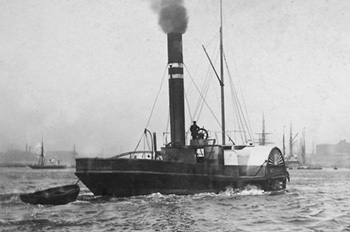Introduction
Essential Question: Where do we look to find truth?
Imagine you are a news reporter who is celebrating New Year's with friends and family before you leave for an assignment covering combat in Cuba. You are excited because this is your first big assignment!
You aren't sure how you can discreetly arrive in Cuba until you meet a captain of a steam tugboat. You decide to come on board as an able-bodied seaman, but you learn this tugboat is now a boat used to smuggle guns.
Shipwreck! text version | Open Shipwreck! in a new tab
Suddenly, your boat begins taking on water, and the boat's pump is broken. Your friend wrote this in his journal.
The engine room ... represented a scene at this time taken from the middle kitchen of hades. In the first place, it was insufferably warm, and the lights burned faintly in a way to cause mystic and grewsome shadows. There was a quantity of soapish sea water swirling and sweeping and swirling among machinery that roared and banged and clattered and steamed .... [A crewman] was sloshing around this inferno filling buckets with water and passing them to a chain of men that extended up the ship's side.
Finally, you and the crew are forced to abandon ship. There is too much water coming aboard. Many get into the life boat; you, the captain, the cook, and the oiler get on the 10' dinghyA small boat designed as a lifeboat..
 You can see a dinghy being pulled behind this tug boat.
You can see a dinghy being pulled behind this tug boat.
You and the crew watch as the boat you want to take you to Cuba sinks. You are twelve miles from Daytona Beach. For thirty miserable hours, you are fighting for your life in the dinghy against tumultuous waves and hungry sharks. Most of the crew aren't as lucky as you. Watch the video to see how you and your friends fought to stay alive that day.
You finally make it to shore. You don't get to report about the combat in Cuba; however, you do manage to write an article about your trip. Read your story that appeared on the front page of the New York Press on January 7, 1897.
 Stephen Crane (1871 - 1900) was one of America's realistic authors. The short story you will read in this lesson was written just days after Crane's dramatic account of being shipwrecked.
Stephen Crane (1871 - 1900) was one of America's realistic authors. The short story you will read in this lesson was written just days after Crane's dramatic account of being shipwrecked.
He was sailing to Cuba on the Commodore to write about the issues that led to the Spanish-American War in 1898. He wrote a detailed account of what the four characters were experiencing as they fought the sea as well as their fears.
Crane was most famous for his novel The Red Badge of Courage, written about a man's physical and psychological experiences of the Civil War. Crane's sense of realism provides the reader with a picture-window view into the life of this soldier.
|
Lesson Objectives
Following successful completion of this lesson, students will be able to:
The above objectives correspond with the Alabama Course of Study: English Language Arts, Grade 10 objectives: 1, 4, 8, 9, 22, 40c, and 42. |
 |